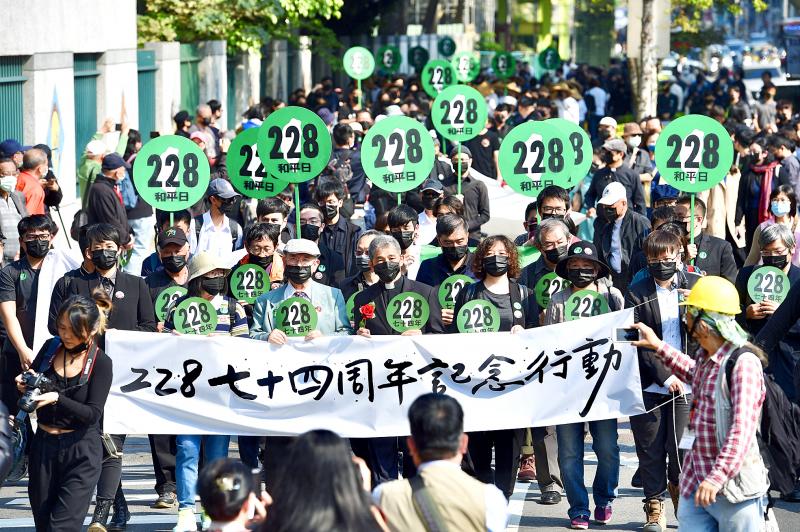More than 200 people yesterday marched in Taipei ahead of the 74th anniversary of the 228 Incident.
The incident refers to a crackdown by the then-Chinese Nationalist Party (KMT) regime against anti-government protests that began on Feb. 28, 1947, when security personnel at the Governor-General’s Office in Taipei — now the site of the Executive Yuan building — opened fire on civilian demonstrators who were demanding the arrest of those responsible for the killing of a bystander in an incident the previous day.
The bystander was part of a crowd that had gathered outside Taipei’s Tianma Tea House (天馬茶房) on Nanjing W Road to challenge Tobacco Monopoly Bureau officials after one of them struck Lin Chiang-mai (林江邁), a woman selling cigarettes illegally.

Photo: Peter Lo, Taipei Times
The incident was followed by the imposition of martial law, which lasted from May 19, 1949, to July 15, 1987, during which political dissidents were suppressed and many were killed.
Yesterday’s rally was the fifth in a series of annual demonstrations first organized in 2017 by the Tsai Jui-yueh Dance Research Institute and the Nylon Cheng Liberty Foundation and Memorial Museum.
The demonstrations are aimed at reminding the government of its “historical duty,” organizers said.
This year’s event was led by the Provisional Office of the Formosa Youth Council and the National Taiwan University Written Taiwanese Society, with “Burying Authoritarianism” and “Making Formosa” the central themes, they said.
Dozens of groups, including the Taiwan Association for Human Rights, Covenants Watch and the 228 Memorial Foundation, were represented at the march, they added.
The marchers, most of whom were dressed in black, gathered outside Rixin Elementary School in Datong District (大同) at about 1:30pm, before starting their march after 2pm.
They walked past the Tianma Tea House, the Taipei branch of the Tobacco Monopoly Bureau and the former site of the Taiwan Broadcasting Station, before stopping at the Executive Yuan.
The purpose of “remembering the past is to move toward a better future,” Nylon Cheng Liberty Foundation and Memorial Museum director Cheng Chu-mei (鄭竹梅) said before the march began.
She urged people to think about the kind of country they wanted, adding: “We should continue to speak while we still can.”
The names of people who died during the 228 Incident were also read aloud during the march.
Pointing out that yesterday’s demonstration coincided with International Mother Language Day, National Taiwan University Written Taiwanese Society president Lim Jiu Sin (林柔辰) said that in addition to lives, language and culture were also taken.
“I hope that everyone can get our mother language back together,” she said in Hoklo (commonly known as Taiwanese).

Beijing could eventually see a full amphibious invasion of Taiwan as the only "prudent" way to bring about unification, the US Department of Defense said in a newly released annual report to Congress. The Pentagon's "Annual Report to Congress: Military and Security Developments Involving the People's Republic of China 2025," was in many ways similar to last year’s report but reorganized the analysis of the options China has to take over Taiwan. Generally, according to the report, Chinese leaders view the People's Liberation Army's (PLA) capabilities for a Taiwan campaign as improving, but they remain uncertain about its readiness to successfully seize

Taiwan is getting a day off on Christmas for the first time in 25 years. The change comes after opposition parties passed a law earlier this year to add or restore five public holidays, including Constitution Day, which falls on today, Dec. 25. The day marks the 1947 adoption of the constitution of the Republic of China, as the government in Taipei is formally known. Back then the Chinese Nationalist Party (KMT) governed China from Nanjing. When the KMT, now an opposition party in Taiwan, passed the legislation on holidays, it said that they would help “commemorate the history of national development.” That

Taiwan has overtaken South Korea this year in per capita income for the first time in 23 years, IMF data showed. Per capita income is a nation’s GDP divided by the total population, used to compare average wealth levels across countries. Taiwan also beat Japan this year on per capita income, after surpassing it for the first time last year, US magazine Newsweek reported yesterday. Across Asia, Taiwan ranked fourth for per capita income at US$37,827 this year due to sustained economic growth, the report said. In the top three spots were Singapore, Macau and Hong Kong, it said. South

HORROR STORIES: One victim recounted not realizing they had been stabbed and seeing people bleeding, while another recalled breaking down in tears after fleeing A man on Friday died after he tried to fight the knife-wielding suspect who went on a stabbing spree near two of Taipei’s busiest metro stations, Taipei Mayor Chiang Wan-an (蔣萬安) said. The 57-year-old man, identified by his family name, Yu (余), encountered the suspect at Exit M7 of Taipei Main Station and immediately tried to stop him, but was fatally wounded and later died, Chiang said, calling the incident “heartbreaking.” Yu’s family would receive at least NT$5 million (US$158,584) in compensation through the Taipei Rapid Transit Corp’s (TRTC) insurance coverage, he said after convening an emergency security response meeting yesterday morning. National